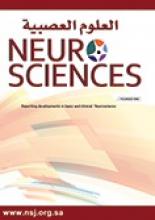ReviewReview
Open Access
Review of electroencephalography signals approaches for mental stress assessment
Eyad T. Attar
Neurosciences Journal October 2022, 27 (4) 209-215; DOI: https://doi.org/10.17712/nsj.2022.4.20220025
Eyad T. Attar
From the Department of Electrical and Computer Engineering, King Abdulaziz University, Jeddah, kingdom of Saudi Arabia
Engr, MD, PhD
References
- 1.↵
- 2.↵
- 3.↵
- Won E,
- Kim Yong-Ku
- 4.↵
- 5.↵
- Yaribeygi H,
- Panahi Y,
- Sahraei H,
- Johnston TP,
- Sahebkar A.
- 6.↵
- 7.↵
- 8.↵
- Lee DY,
- Kim E,
- Choi MH.
- 9.↵
- Tsigos C,
- Kyrou I,
- Kassi E,
- Chrousos GP. Stress
- 10.↵
- Giannakakis G,
- Grigoriadis D,
- Giannakaki K,
- Simantiraki O,
- Roniotis A,
- Tsiknakis M.
- 11.↵
- 12.↵
- St. Louis EK
- 13.↵
- 14.↵
- Jacks AS,
- Miller NR.
- Hans Berger
- 15.↵
- İnce R,
- Adanır SS,
- Sevmez F.
- 16.↵
- Teplan SM.
- 17.↵
- Attar ET,
- Balasubramanian V,
- Subasi E,
- Kaya M.
- 18.↵
- Bronzino JD,
- Peterson DR
- 19.↵
- 20.↵
- Baura GD
- 21.↵
- Nayak CS,
- Anilkumar AC.
- 22.↵
- 23.↵
- 24.↵
- Jiang X,
- Bin Bian G,
- Tian Z.
- 25.↵
- Kumar JS,
- Bhuvaneswari P.
- 26.↵
- 27.↵
- Gao Y,
- Gao B,
- Chen Q,
- Liu J,
- Zhang Y.
- 28.↵
- Höller P,
- Trinka E,
- Höller Y.
- 29.↵
- 30.↵
- Silverman D.
- 31.↵
- Matthes J,
- Davis CS,
- Potter RF
- Read GL,
- Innis IJ.
- 32.↵
- Sazgar M,
- Young MG
- 33.↵
- Faigle R,
- Sutter R,
- Kaplan PW.
- 34.↵
- 35.↵
- Reiher J,
- Beaudry M,
- Leduc CP.
- 36.↵
- Britton JW,
- Frey LC,
- Hopp JLet
- 37.↵
- Koudelková Z,
- Strmiska M.
- 38.↵
- Hardgrave MD.
- 39.↵
- 40.↵
- 41.↵
- Blum AS,
- Rutkove SB
- Schomer DL.
- 42.↵
- Andraus MEC,
- Alves-Leon SV.
- 43.↵
- Aich TK.
- 44.↵
- Azabou E,
- Navarro V,
- Kubis N,
- Gavaret M,
- Heming N,
- Cariou A.
- 45.↵
- Al Sawaf A,
- Gudlavalleti A,
- Murr N.
- 46.↵
- Cervone, RL,
- Blum AS.
- 47.↵
- García-Monge A,
- Rodríguez-Navarro H,
- González-Calvo G,
- Bores-García D.
- 48.↵
- Patel AK,
- Reddy V,
- Araujo JF. Physiology,
- Sleep Stages
- 49.↵
- 50.↵
- 51.↵
- 52.↵
- 53.↵
- Warner S.
- 54.↵
- 55.↵
- 56.↵
- Butt M,
- Espinal E,
- Aupperle RL,
- Nikulina V,
- Stewart JL.
- 57.↵
- Andrade ALM,
- De Micheli D.
- 58.↵
- Sarnthein J,
- Jeanmonod D.
- 59.↵
- 60.↵
- Staudigl T,
- Hanslmayr S.
- 61.↵
- Newson JJ,
- Thiagarajan TC.
- 62.↵
- Roux F,
- Wibra M,
- Singer W,
- Aru J,
- Uhlhaas PJ.
- 63.↵
- Colrain IM,
- Nicholas CL,
- Baker FC.
- 64.↵
- Li G,
- Huang S,
- Xu W,
- Jiao W,
- Jiang Y,
- Gao Z, et al.
- 65.↵
- 66.↵
- Groppe DM,
- Bickel S,
- Keller CJ,
- Jain SK,
- Hwang ST,
- Harden C, et al.
- 67.↵
- Zhao G,
- Zhang Y,
- Ge Y,
- Zheng Y,
- Sun X,
- Zhang K.
- 68.↵
- 69.↵
- 70.↵
- Klimesch W.
- 71.↵
- Kučikienė D,
- Praninskienė R.
- 72.↵
- 73.↵
- 74.
- 75.
- Ribas VR,
- Ribas RG,
- Nóbrega JdA,
- da Nóbrega MV,
- Espécie JA,
- Calafange MT, et al.
- 76.
- Attar ET.
- 77.
- Attar ET,
- Kaya M.
- 78.↵
- Attar ET.
In this issue
Review of electroencephalography signals approaches for mental stress assessment
Eyad T. Attar
Neurosciences Journal Oct 2022, 27 (4) 209-215; DOI: 10.17712/nsj.2022.4.20220025
Jump to section
Related Articles
- No related articles found.





